Investigating the Role of Flight Phase and Task Difficulty on Low-Time Pilot Performance, Gaze Dynamics and Subjective Situation Awareness During Simulated Flight
Abstract
1. Introduction
2. Methods
2.1. Participants
2.2. Experimental Setup and Apparatus
2.3. Data Reduction
2.4. Performance, Gaze, and Situation Awareness Analysis


2.5. Statistical Analysis
3. Results
3.1. The Effects of Task Difficulty on Landing Performance and Aircraft Control
3.2. The Effects of Task Difficulty on Gaze Behaviour
3.3. The Effects of Task Difficulty on Situation Awareness
4. Discussion
4.1. Examining the Effectiveness of the Task Difficulty Manipulation
4.2. Flight Phase Parameters and Experience Influence Information Processing
4.3. Limitations and Future Directions
4.4. Conclusion
Ethics and Conflict of Interest
Acknowledgments
References
- Allsop, J., and R. Gray. 2014. Flying under pressure: Effects of anxiety on attention and gaze behavior in aviation. Journal of Applied Research in Memory and Cognition 3, 2: 63–71. [Google Scholar]
- Allsop, J., R. Gray, H. Bülthoff, and L. Chuang. 2017. Eye movement planning on Single-Sensor-Single-Indicator displays is vulnerable to user anxiety and cognitive load. Journal of Eye Movement Research 10, 5. [Google Scholar] [CrossRef]
- Andrzejewska, M., and A. Stolińska. 2016. Comparing the Difficulty of Tasks Using Eye Tracking Combined with Subjective and Behavioural Criteria. Journal of Eye Movement Research 9, 3. [Google Scholar] [CrossRef]
- Ayala, N., D. Mardanbegi, A. Duchowski, E. Niechwiej-Szwedo, S. Cao, S. Kearns, and E. Irving. 2023. On The Visibility Of Fiducial Markers For Mobile Eye Tracking. Proceedings of the 2023 Symposium on Eye Tracking Research and Applications, May; pp. 1–7. [Google Scholar]
- Ayala, N., A. Zafar, S. Kearns, E. Irving, S. Cao, and E. Niechwiej-Szwedo. 2023. The effects of task difficulty on gaze behaviour during landing with visual flight rules in low-time pilots. Journal of Eye Movement Research 16, 1. [Google Scholar]
- Ayala, N., A. Zafar, and E. Niechwiej-Szwedo. 2022. Gaze behaviour: A window into distinct cognitive processes revealed by the Tower of London test. Vision Research. [Google Scholar]
- Babu, M. D., D. V. JeevithaShree, G. Prabhakar, K. P. S. Saluja, A. Pashilkar, and P. Biswas. 2019. Estimating pilots’ cognitive load from ocular parameters through simulation and inflight studies. Journal of Eye Movement Research 12, 3. [Google Scholar] [CrossRef]
- Beall, A. C., and J. M. Loomis. 1997. Optic flow and visual analysis of the base-to-final turn. The International Journal of Aviation Psychology 7, 3: 201–223. [Google Scholar]
- Bell, M. A., E. L. Facci, and R. V. Nayeem. 2005. Cognitive Tunneling, Aircraft-Pilot Coupling Design Issues and Scenario Interpretation Under Stress in Recent Airline Accidents. 2005 International Symposium on Aviation Psychology; pp. 45–49. [Google Scholar]
- Bellenkes, A. H., C. D. Wickens, and A. F. Kramer. 1997. Visual scanning and pilot expertise: The role of attentional flexibility and mental model development. Aviation, Space, and Environmental Medicine 68: 569–579. [Google Scholar]
- Boeing. 2021. Statistical Summary of Commercial Jet Airplane Accidents-Worldwide Operations 1959–2021. https://www.boeing.com/resources/boeingdotcom/company/about_bca/pdf/statsum.pdf.
- Brams, S., I. T. Hooge, G. Ziv, S. Dauwe, K. Evens, T. De Wolf, and W. F. Helsen. 2018. Does effective gaze behavior lead to enhanced performance in a complex error-detection cockpit task? PLoS ONE 13, 11: e0207439. [Google Scholar]
- Brams, S., G. Ziv, O. Levin, J. Wagemans, A. M. Williams, and W. F. Helsen. 2020. Brain, gaze behavior and perceptual-cognitive skills in aviation: What is yet to be studied? In Eye-Tracking in Aviation. Proceedings of the 1st International Workshop (ETAVI 2020). ISAE-SUPAERO, Université de Toulouse; Institute of Cartography and Geoinformation (IKG), ETH Zurich: pp. 100–107. [Google Scholar]
- Ciuperca, G., and V. Girardin. 2007. Estimation of the entropy rate of a countable Markov chain. Communications in Statistics—Theory and Methods 36, 14: 2543–2557. [Google Scholar]
- de Brouwer, A. J., J. R. Flanagan, and M. Spering. 2021. Functional use of eye movements for an acting system. Trends in Cognitive Sciences 25, 3: 252–263. [Google Scholar]
- Dehais, F., J. Behrend, V. Peysakhovich, M. Causse, and C. D. Wickens. 2017. Pilot flying and pilot monitoring’s aircraft state awareness during go-around execution in aviation: A behavioral and eye tracking study. The International Journal of Aerospace Psychology 27, 1–2: 15–28. [Google Scholar]
- Dehais, F., S. Juaneda, and V. Peysakhovich. 2020. Monitoring eye movements in real flight conditions for flight training purpose. ETAVI ’20-Proceedings of the 1st International Workshop on Eye-Tracking in Aviation 6: 54–60. [Google Scholar]
- Di Nocera, F., M. Camilli, and M. Terenzi. 2007. A random glance at the flight deck: Pilots’ scanning strategies and the real-time assessment of mental workload. Journal of Cognitive Engineering and Decision Making 1, 3: 271–285. [Google Scholar]
- Diaz-Piedra, C., H. Rieiro, A. Cherino, L. J. Fuentes, A. Catena, and L. L. Di Stasi. 2019. The effects of flight complexity on gaze entropy: An experimental study with fighter pilots. Applied Ergonomics 77: 92–99. [Google Scholar]
- Endsley, M. R. 1988. Design and Evaluation for Situation Awareness Enhancement. Proceedings of the Human Factors Society Annual Meeting 32: 97–101. [Google Scholar]
- Endsley, M. R. 1995. Measurement of situation awareness in dynamic systems. Human factors 37, 1: 65–84. [Google Scholar] [CrossRef]
- Engström, J., E. Johansson, and J. Östlund. 2005. Effects of visual and cognitive load in real and simulated motorway driving. Transportation research part F: Traffic psychology and behaviour 8, 2: 97–120. [Google Scholar]
- Eysenck, M. W., N. Derakshan, R. Santos, and M. G. Calvo. 2007. Anxiety and cognitive performance: Attentional control theory. Emotion 7, 2: 336. [Google Scholar] [CrossRef] [PubMed]
- Federal Aviation Administration. 2021. Airplane Flying Handbook. (FAA-H-8083-3C). Washington, DC: Federal Aviation Administration . [Google Scholar]
- Gidlöf, K., A. Wallin, R. Dewhurst, and K. Holmqvist. 2013. Using Eye Tracking to Trace a Cognitive Process: Gaze Behaviour During Decision Making in a Natural Environment. Journal of Eye Movement Research 6, 1. [Google Scholar] [CrossRef]
- Glaholt, M. G. 2014. Eye tracking in the cockpit: A review of the relationships between eye movements and the aviators cognitive state. https://apps.dtic.mil/sti/pdfs/AD1000097.pdf.</u>.
- Gray, R., J. A. Navia, and J. Allsop. 2014. Action-specific effects in aviation: What determines judged runway size? Perception 43, 2–3: 145–154. [Google Scholar]
- Hebbar, A., S. Vinod, S. A. K., A. Pashilkar, and P. Biswas. 2023. Cognitive load estimation in VR flight simulator. Journal of Eye Movement Research 15, 3. [Google Scholar] [CrossRef]
- Hermens, F., R. Flin, and I. Ahmed. 2013. Eye movements in surgery: A literature review. Journal of Eye Movement Research 6, 4. [Google Scholar] [CrossRef]
- International Air Transport Association. 2023. Competency Assessment and Evaluation for Pilots, Instructors, and Evaluators. GUIDANCE MATERIAL. [Google Scholar]
- Kim, J., S. A. Palmisano, A. Ash, and R. S. Allison. 2008. Pilot gaze and glideslope control. ACM Transactions on Applied Perception (TAP) 7, 3: 1–18. [Google Scholar]
- Kübler, T. C., E. Kasneci, W. Rosenstiel, K. Aehling, M. Heister, K. Nagel, U. Schiefer, and E. Papageorgiou. 2015. Driving with Homonymous Visual Field Defects: Driving Performance and Compensatory Gaze Movements. Journal of Eye Movement Research 8, 5. [Google Scholar] [CrossRef]
- Land, M. F., and M. Hayhoe. 2001. In what ways do eye movements contribute to everyday activities? Vision Research 41, 25–26: 3559–3565. [Google Scholar]
- Lijing, W., and C. Lin. 2016. Eye movement comparison of professional and novice pilots in key actions of takeoff phase. 2016 IEEE International Conference on Aircraft Utility Systems (AUS); pp. 703–706. [Google Scholar]
- Martinez-Conde, S., J. Otero-Millan, and S. L. Macknik. 2013. The impact of microsaccades on vision: Towards a unified theory of saccadic function. Nature Reviews Neuroscience 14, 2: 83–96. [Google Scholar] [CrossRef] [PubMed]
- Mertens, H. W., and M. F. Lewis. 1981. Effect of different runway size on pilot performance during simulated night landing approaches. FEDERAL AVIATION ADMINISTRATION WASHINGTON DC OFFICE OF AVIATION MEDICINE. [Google Scholar]
- National Transportation Safety Board. 1994. A Review of Flightcrew-Involved, Major Accidents of US Air Carriers, 1978 Through 1990. https://reports.aviation-safety.net/1994/19940618-1_LJ25_XA-BBA.pdf</u.
- Noble, C. 2002. The Relationship Between Fidelity And Learning In Aviation Training And Assessment. Journal of Air Transportation 7, 3. [Google Scholar]
- Nyström, M., and K. Holmqvist. 2010. An adaptive algorithm for fixation, saccade, and glissade detection in eyetracking data. Behavior Research Methods 42, 1: 188–204. [Google Scholar]
- Peißl, S., C. D. Wickens, and R. Baruah. 2018. Eye-tracking measures in aviation: A selective literature review. The International Journal of Aerospace Psychology 28, 3–4: 98–112. [Google Scholar]
- Reimer, B. 2009. Impact of cognitive task complexity on drivers’ visual tunneling. Transportation Research Record: Journal of the Transportation Research Board 2138: 13–19. [Google Scholar]
- Robinski, M., and M. Stein. 2013. Tracking Visual Scanning Techniques in Training Simulation for Helicopter Landing. Journal of Eye Movement Research 6, 2. [Google Scholar] [CrossRef]
- Sarter, N. B., R. J. Mumaw, and C. D. Wickens. 2007. Pilots’ monitoring strategies and performance on automated flight decks: An empirical study combining behavioral and eye-tracking data. Human Factors 49, 3: 347–357. [Google Scholar] [PubMed]
- Selcon, S. J., R. M. Taylor, and E. Koritsas. 1991. Workload or situational awareness?: TLX vs. SART for aerospace systems design evaluation. Proceedings of the Human Factors Society Annual Meeting, Sage CA, Los Angeles, CA, September; SAGE Publications, Vol. 35, pp. 62–66. [Google Scholar]
- Shannon, C. E. 1984. A Mathematical Theory of Communication. In The Bell System Technical Journal 27, 3: 379–423. [Google Scholar]
- Shappell, S. A., and D. A. Wiegmann. 2000. The human factors analysis and classification system-HFACS.
- Shiferaw, B. A., L. A. Downey, J. Westlake, B. Stevens, S. M. Rajaratnam, D. J. Berlowitz, and M. E. Howard. 2018. Stationary gaze entropy predicts lane departure events in sleep-deprived drivers. Scientific Reports 8, 1: 1–10. [Google Scholar]
- Shiferaw, B., L. Downey, and D. Crewther. 2019. A review of gaze entropy as a measure of visual scanning efficiency. Neuroscience and Biobehavioral Reviews 96: 353–366. [Google Scholar]
- Stuhr, C., C. M. L. Hughes, and T. Stöckel. 2018. Task-specific and variability-driven activation of cognitive control processes during motor performance. Scientific reports 8, 1: 10811. [Google Scholar]
- Sun, Q., J. (Cecilia) Xia, T. Falkmer, and H. Lee. 2016. Investigating the Spatial Pattern of Older Drivers’ Eye Fixation Behaviour and Associations with Their Visual Capacity. Journal of Eye Movement Research 9, 6. [Google Scholar] [CrossRef]
- Svensson, E., M. Angelborg-Thanderez, L. Sjöberg, and S. Olsson. 1997. Information complexity-mental workload and performance in combat aircraft. Ergonomics 40, 3: 362–380. [Google Scholar] [CrossRef]
- Tang, H., E. Day, L. Kendhammer, J. N. Moore, S. A. Brown, and N. J. Pienta. 2016. Eye Movement Patterns in Solving Science Ordering Problems. Journal of Eye Movement Research 9, 3. [Google Scholar] [CrossRef]
- Taylor, R. M., and S. J. Selcon. 1990. Cognitive Quality and Situational Awareness with Advanced Aircraft Attitude Displays. Proceedings of the Human Factors Society Annual Meeting 34, 1: 26–30. [Google Scholar]
- van De Merwe, K., H. Van Dijk, and R. Zon. 2012. Eye movements as an indicator of situation awareness in a flight simulator experiment. The International Journal of Aviation Psychology 22, 1: 78–95. [Google Scholar]
- van Dijk, H., K. van de Merwe, and R. Zon. 2011. A Coherent Impression of the Pilots’ Situation Awareness: Studying relevant human factors tools. The International Journal of Aviation Psychology 21, 4: 343–356. [Google Scholar]
- van Leeuwen, P. M., R. Happee, and J. C. de Winter. 2015. Changes of driving performance and gaze behavior of novice drivers during a 30-min simulator-based training. Procedia Manufacturing 3: 3325–3332. [Google Scholar] [CrossRef][Green Version]
- Vlačić, S., A. Knežević, S. Rođenkov, S. Mandal, and P. A. Vitsas. 2020. Improving the pilot selection process by using eye-tracking tools. Journal of Eye Movement Research 12, 3. [Google Scholar] [CrossRef]
- Wang, Y., B. Reimer, J. Dobres, and B. Mehler. 2014. The sensitivity of different methodologies for characterizing drivers’ gaze concentration under increased cognitive demand. Transportation Research Part F: Traffic Psychology and Behaviour 26: 227–237. [Google Scholar]
- Xiong, W., Y. Wang, Q. Zhou, Z. Liu, and X. Zhang. 2016. The research of eye movement behavior of expert and novice in flight simulation of landing. In International Conference on Engineering Psychology and Cognitive Ergonomics; pp. 485–493. [Google Scholar]
- Yang, S., J. Kuo, and M. G. Lenné. 2018. Analysis of gaze behaviour to measure cognitive distraction in real-world driving. Proceedings of Human Factors and Ergonomics Society Annual Meeting 62: 1944–1948. [Google Scholar]
- Yang, S., K. M. Wilson, T. Roady, J. Kuo, and M. G. Lenné. 2022. Evaluating driver features for cognitive distraction detection and validation in manual and Level 2 automated driving. Human Factors 64, 4: 746–759. [Google Scholar] [PubMed]
- Yarbus, A. L. 1967. Eye Movements and Vision. Unite States: Springer. [Google Scholar] [CrossRef]
- Zafar, A., C. Martin Calderon, A. M. Yeboah, K. Dalton, E. Irving, and E. Niechwiej-Szwedo. 2023. Investigation of Camera-Free Eye-Tracking Glasses Compared to a Video-Based System. Sensors 23, 18: 7753. [Google Scholar] [CrossRef]
- Ziv, G. 2016. Gaze behavior and visual attention: A review of eye tracking studies in aviation. The International Journal of Aviation Psychology 26, 3–4: 75–104. [Google Scholar]
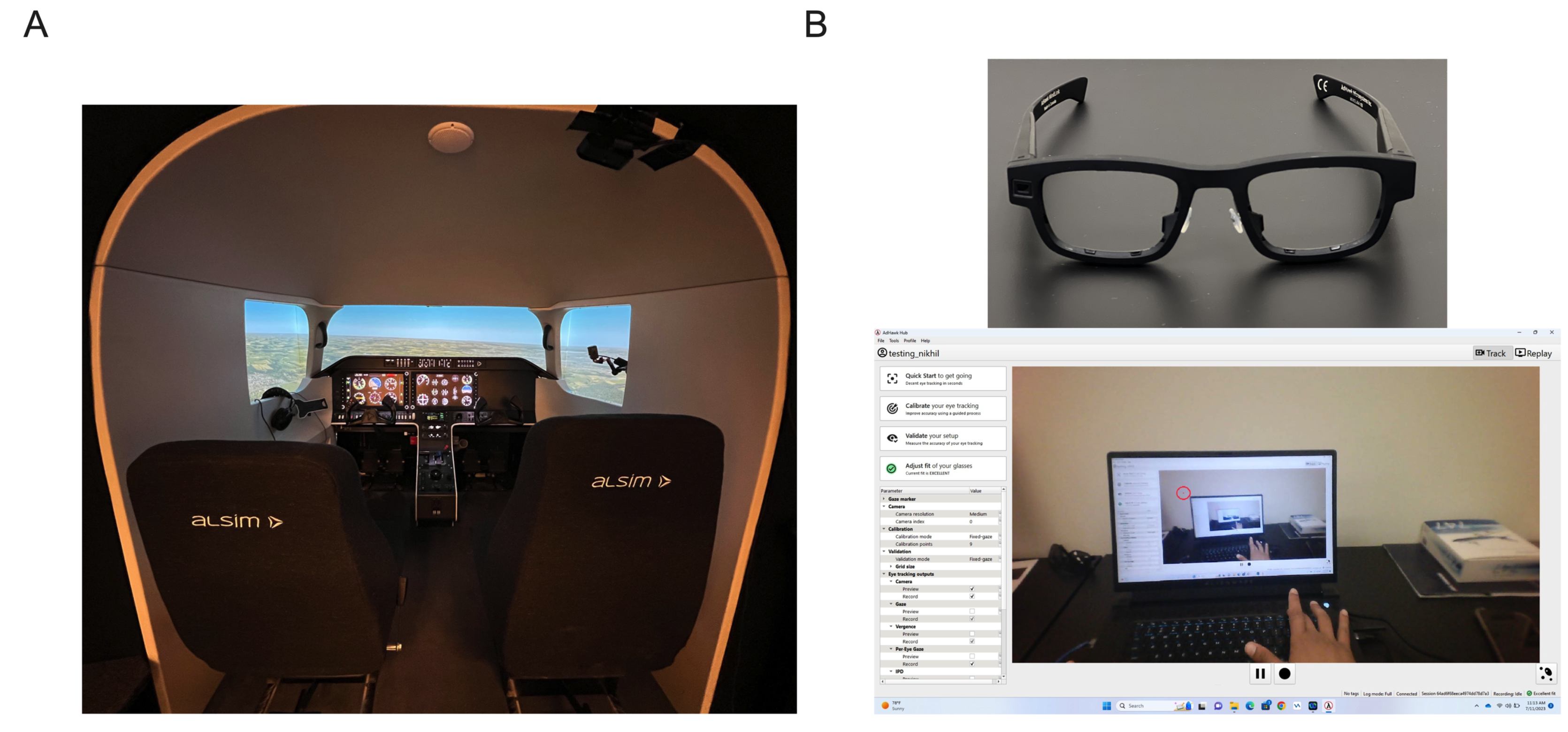

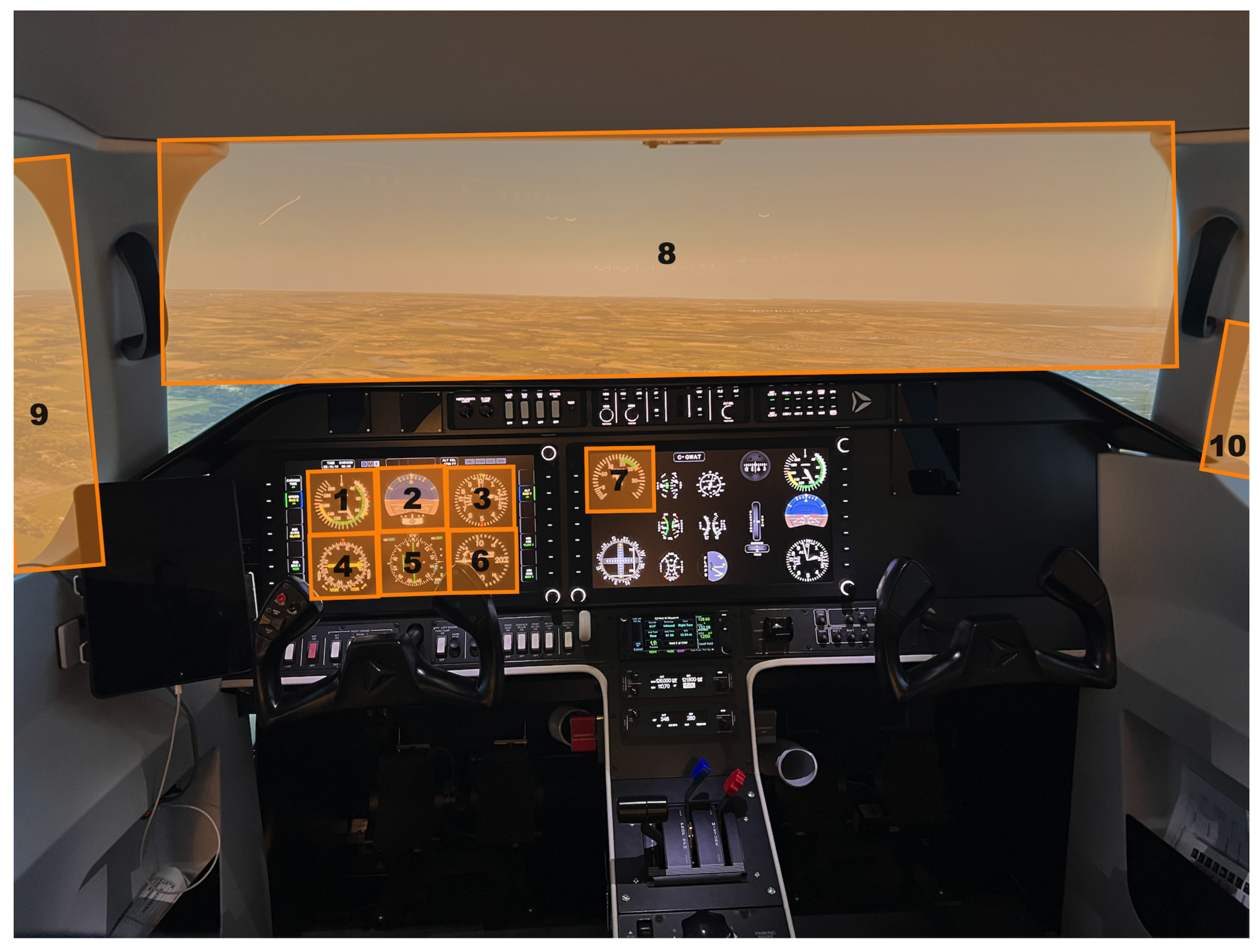

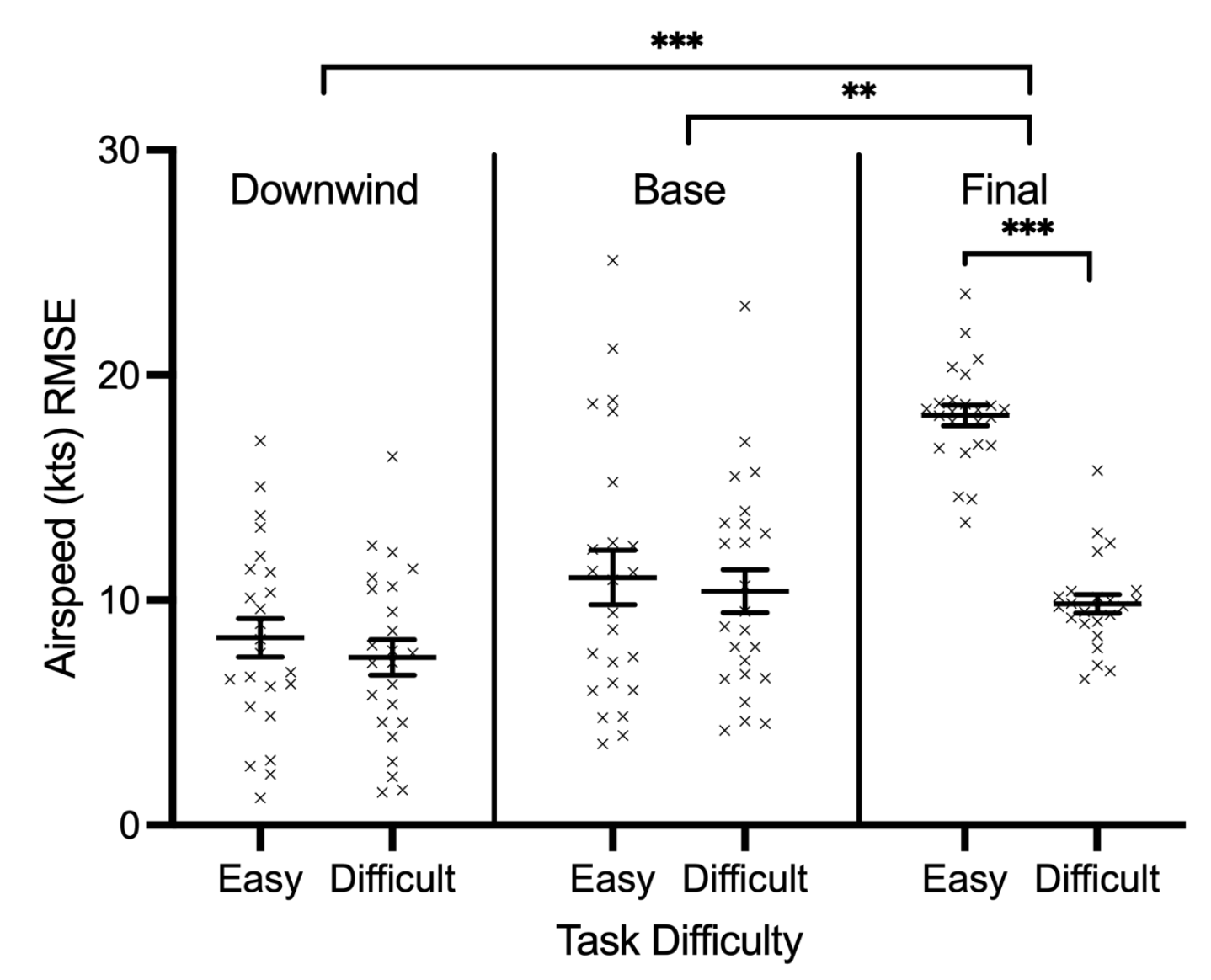



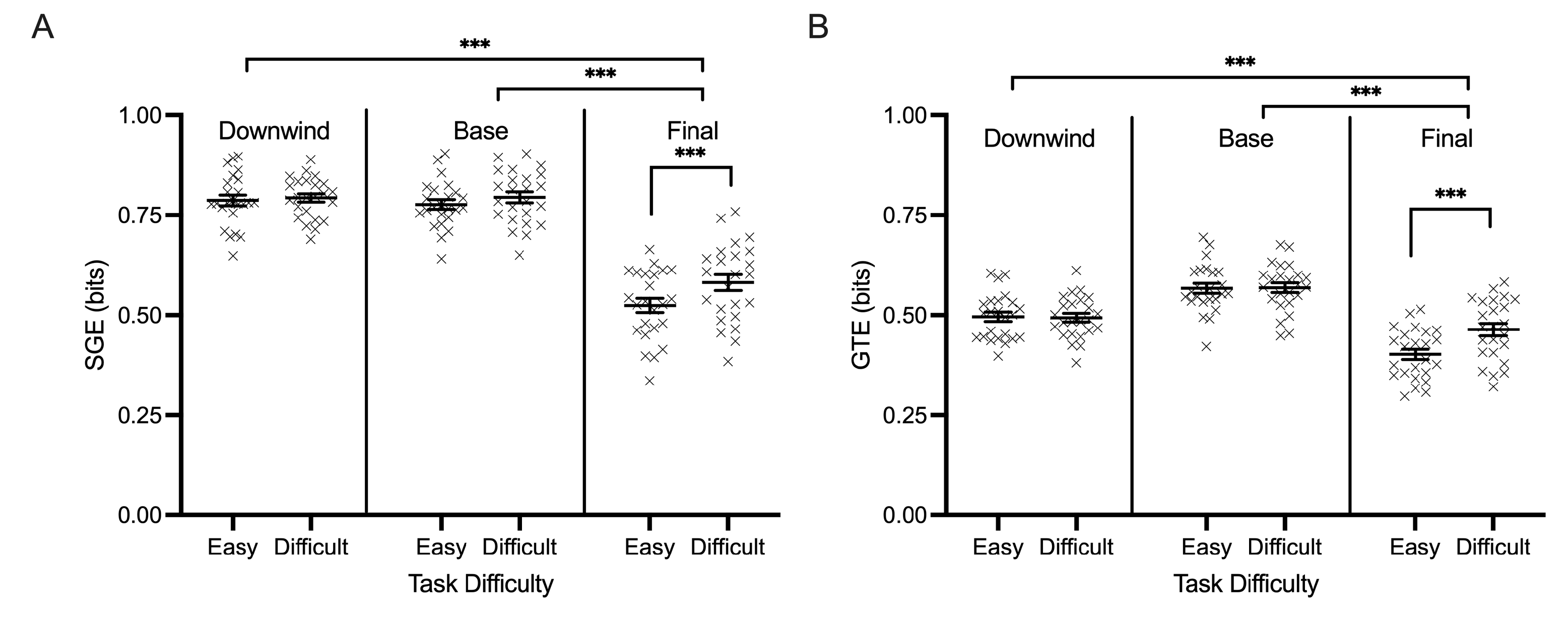
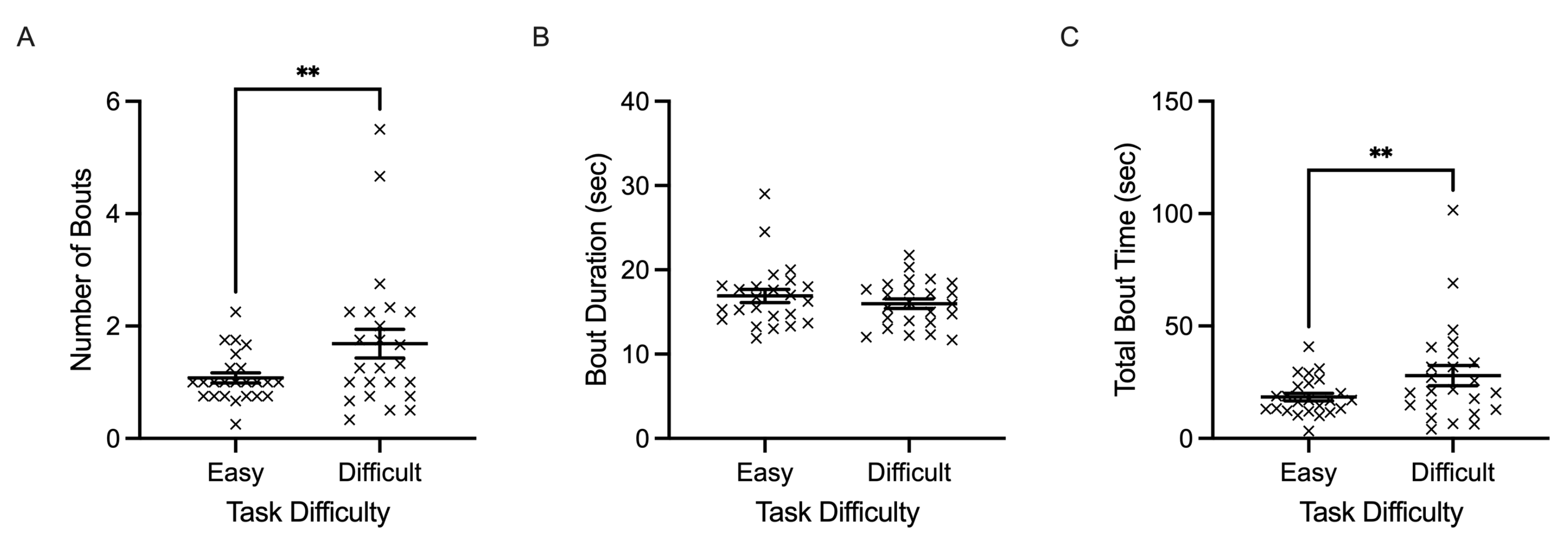
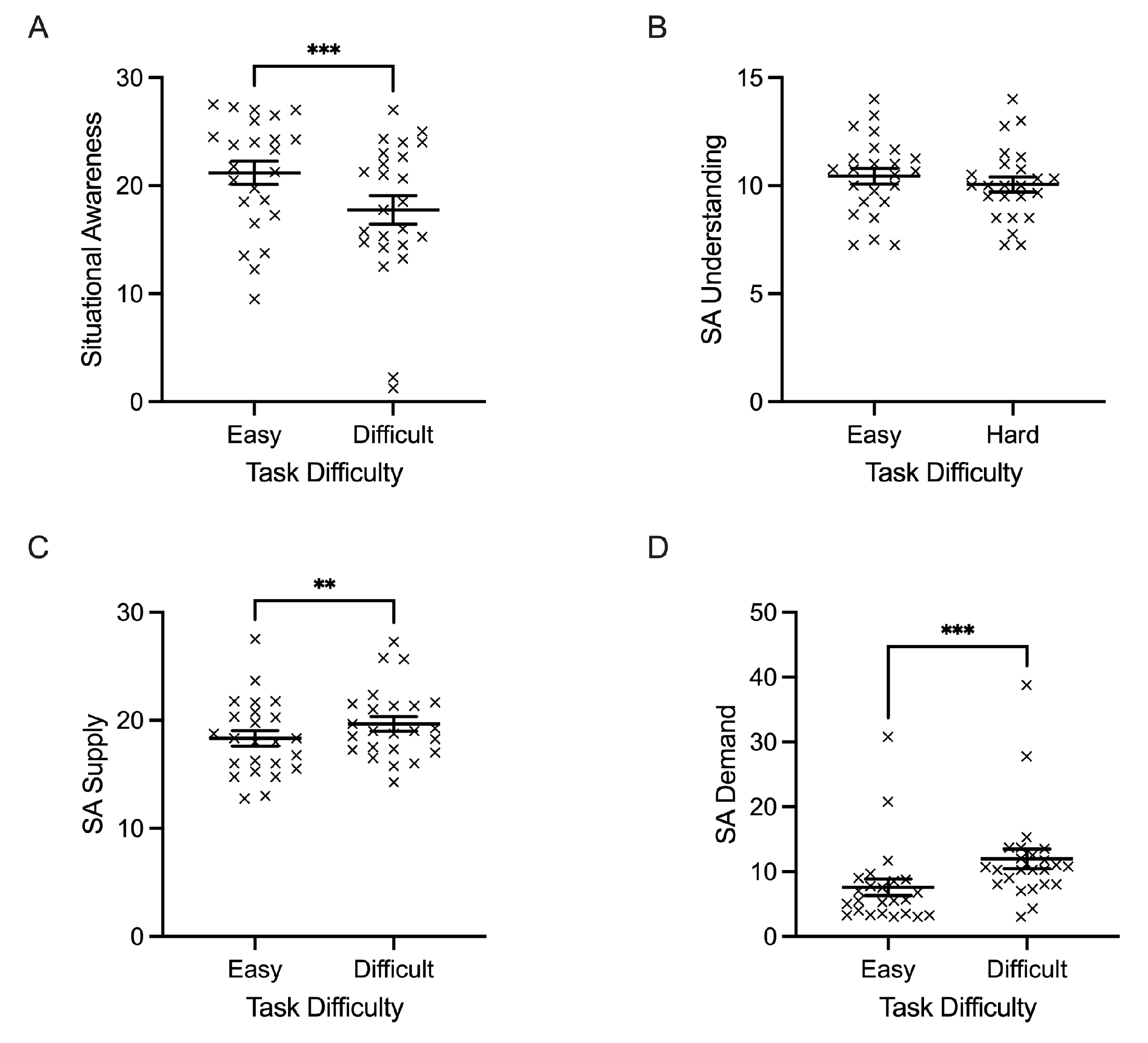
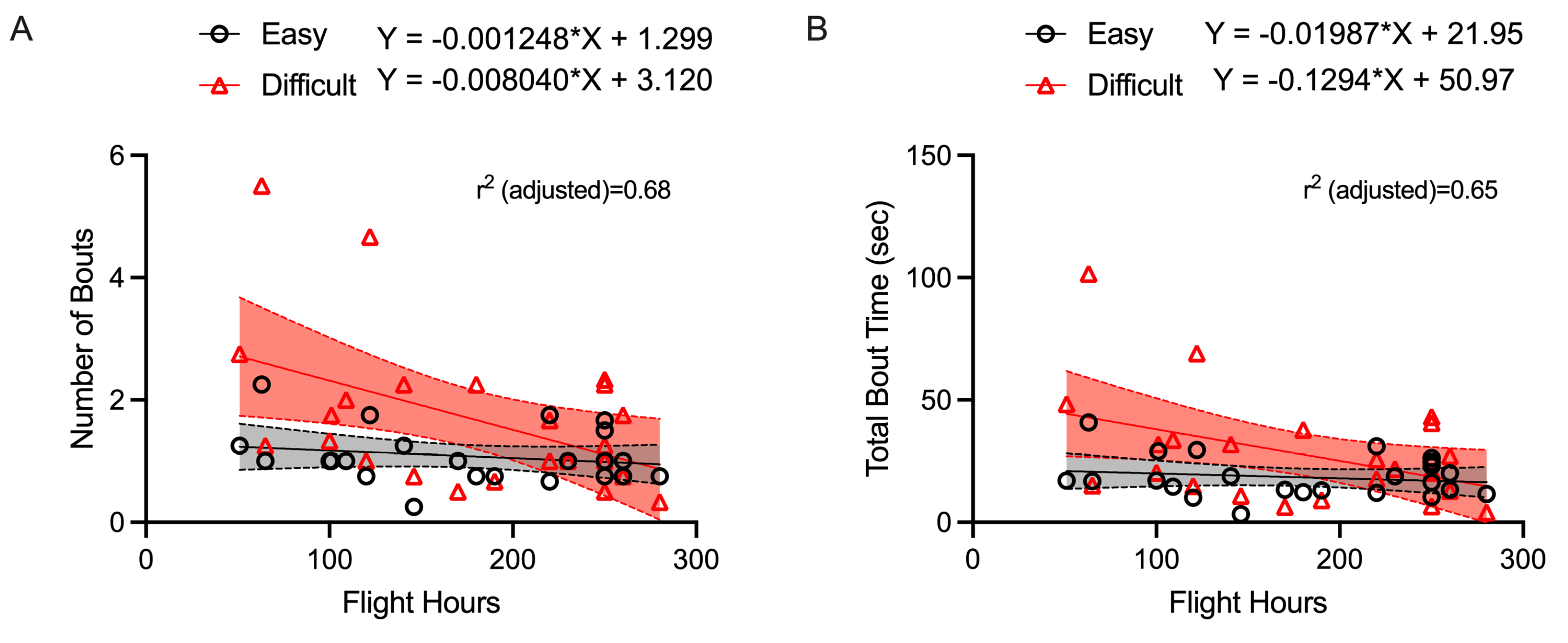
| Phase of Flight | Downwind | Base | Final | |||
|---|---|---|---|---|---|---|
| Task Difficulty | Easy | Difficult | Easy | Difficult | Easy | Difficult |
| AIRSPEED | 10.22 (6.19) * | 9.82 (6.64) * | 18.92 (9.76) * | 17.69 (7.63) * | 13.36 (5.49) * | 12.62 (4.75) * |
| ATTITUDE | 6.85 (4.93) | 6.62 (4.33) | 9.16 (7.31) | 9.35 (6.25) | 1.38 (1.16) | 1.44 (1.51) |
| ALTIMETER | 10.95 (6.47) | 12.02 (6.60) | 5.33 (3.25) | 5.72 (3.41) | 1.47 (0.80) | 1.40 (1.04) |
| VOR | 2.28 (2.25) | 2.39 (2.91) | 2.59 (4.65) | 4.38 (5.21) | 0.69 (0.97) | 0.92 (1.26) |
| HEADING | 4.15 (5.98) | 4.64 (5.89) | 3.48 (4.53) * | 3.59 (4.16) * | 1.07 (1.77) | 1.11 (1.06) |
| VERTICAL SPEED | 2.89 (4.19) | 2.03 (1.87) | 1.17 (1.23) | 1.59 (1.71) | 0.46 (0.58) | 0.57 (0.38) |
| POWER | 10.66 (6.66) | 11.40 (6.41) | 4.04 (2.43) | 3.45 (2.29) | 2.00 (1.42) | 2.60 (1.64) |
| FRONT WINDOW | 15.90 (10.53) | 15.96 (10.16) | 15.12 (6.99) | 17.36 (7.74) | 69.16 (8.77) | 69.84 (8.83) |
| LEFT WINDOW | 7.59 (4.97) * | 7.08 (5.85) * | 23.02 (9.36) * | 20.74 (7.59) * | 0.21 (0.64) * | 0.16 (0.22) * |
| RIGHT WINDOW | 0.01 (0.03) | 0.00 (0.00) | 0.23 (0.64) | 0.11 (0.27) | 0.00 (0.00) | 0.04 (0.12) |
| Phase of Flight | Downwind | Base | Final | |||
|---|---|---|---|---|---|---|
| Task Difficulty | Easy | Difficult | Easy | Difficult | Easy | Difficult |
| AIRSPEED | 0.15 (0.07) | 0.16 (0.09) | 0.12 (0.04) | 0.12 (0.03) | 0.13 (0.04) | 0.13 (0.04) |
| ATTITUDE | 0.23 (0.13) | 0.23 (0.12) | 0.14 (0.04) | 0.16 (0.05) | 0.34 (0.21) | 0.31 (0.23) |
| ALTIMETER | 0.16 (0.07) | 0.15 (0.06) | 0.15 (0.05) | 0.15 (0.05) | 0.24 (0.13) | 0.21 (0.08) |
| VOR | 0.22 (0.22) | 0.17 (0.18) | 0.22 (0.19) | 0.21 (0.23) | 0.11 (0.13) | 0.19 (0.16) |
| HEADING | 0.2 (0.13) | 0.23 (0.17) | 0.19 (0.09) | 0.22 (0.13) | 0.25 (0.23) | 0.18 (0.09) |
| VERTICAL SPEED | 0.17 (0.12) | 0.23 (0.17) | 0.26 (0.28) | 0.19 (0.14) | 0.25 (0.37) | 0.31 (0.28) |
| POWER | 0.13 (0.06) | 0.12 (0.04) | 0.14 (0.11) | 0.15 (0.09) | 0.15 (0.05) | 0.15 (0.04) |
| FRONT WINDOW | 0.14 (0.04) | 0.15 (0.04) | 0.10 (0.03) | 0.09 (0.03) | 0.06 (0.02) | 0.05 (0.02) |
| LEFT WINDOW | 0.28 (0.12) | 0.28 (0.10) | 0.15 (0.06) | 0.15 (0.06) | 0.17 (0.33) | 0.12 (0.17) |
| RIGHT WINDOW | 0.04 (0.21) * | 0.00 (0.00) * | 0.13 (0.34) * | 0.13 (0.23) * | 0.00 (0.00) * | 0.16 (0.41) * |
| Phase of Flight | Downwind | Base | Final |
|---|---|---|---|
| AIRSPEED | 532.91 (204.69) | 565.06 (147.07) | 524.47 (131.64) |
| ATTITUDE | 480.56 (168.65) ##* | 453.15 (147.53)##^^^ | 349.93 (97.51) *^^^ |
| ALTIMETER | 361.47 (124.35) ** | 447.37 (101.27) ^ | 280.25 (113.79) **^ |
| VOR | 413.65 (238.48) | 418.71 (125.04) | 380.76 (191.25) |
| HEADING | 397.02 (183.28) | 434.37 (166.41) | 349.71 (146.11) |
| VERTICAL SPEED | 343.73 (207.28) | 413.82 (354.28) | 311.95 (153.20) |
| POWER | 650.19 (235.11) *** | 556.47 (151.79) ^ | 453.59 (86.69) ***^ |
| FRONT WINDOW | 491.99 (126.69) ###*** | 698.11 (198.73) ###^^^ | 1349.43 (550.27) ***^^^ |
| LEFT WINDOW | 240.07 (169.58) | 402.44 (259.71) | 244.93 (213.39) |
| RIGHT WINDOW | - | - | - |
| Phase of Flight | Downwind | Base | Final | |||
|---|---|---|---|---|---|---|
| Task Difficulty | Easy | Difficult | Easy | Difficult | Easy | Difficult |
| Stationary Gaze Entropy (SGE) | 2.61 (1.07) | 2.6 (0.83) | 2.58 (0.92) | 2.64 (1.08) | 1.74 (1.42) *** | 1.93 (1.61) *** |
| Gaze Transition Entropy (GTE) | 1.65 (0.93) | 1.64 (0.83) | 1.88 (0.98) | 1.89 (0.93) | 1.33 (1.02) *** | 1.54 (1.22) *** |
| Dependent Variable | Task Difficulty | Flight Hours | Task Difficulty x Flight Hours Interaction | |||
|---|---|---|---|---|---|---|
| Coefficient, [95%CI] | R^2 | Coefficient, [95%CI] | R^2 | Coefficient, [95%CI] | R^2 | |
| Number of Bouts | 0.432, [0.067, 1.155] | 0.081 | −0.005, [−0.008, −0.001] | 0.1 | Easy: −0.00125, [−0.006, 0.004] Difficult: −0.00804, [−0.013, −0.003] | 0.68 |
| Total Bout Time | 6.722, [−0.153, 19.167] | 0.059 | −0.075, [−0.141, −0.008] | 0.081 | Easy: −0.0199, [−0.109, 0.069] Difficult: −0.1294, [−0.219, −0.039] | 0.65 |
Disclaimer/Publisher’s Note: The statements, opinions and data contained in all publications are solely those of the individual author(s) and contributor(s) and not of MDPI and/or the editor(s). MDPI and/or the editor(s) disclaim responsibility for any injury to people or property resulting from any ideas, methods, instructions or products referred to in the content. |
© 2024, Ayala, N., Kearns, S., Irving, E., Cao, S., & Niechwiej-Szwedo, E. This article is licensed under a Creative Commons Attribution 4.0 International license (https://creativecommons.org/licenses/by/4.0/).
Share and Cite
Ayala, N.; Kearns, S.; Irving, E.; Cao, S.; Niechwiej-Szwedo, E. Investigating the Role of Flight Phase and Task Difficulty on Low-Time Pilot Performance, Gaze Dynamics and Subjective Situation Awareness During Simulated Flight. J. Eye Mov. Res. 2024, 17, 1-28. https://doi.org/10.16910/jemr.17.1.6
Ayala N, Kearns S, Irving E, Cao S, Niechwiej-Szwedo E. Investigating the Role of Flight Phase and Task Difficulty on Low-Time Pilot Performance, Gaze Dynamics and Subjective Situation Awareness During Simulated Flight. Journal of Eye Movement Research. 2024; 17(1):1-28. https://doi.org/10.16910/jemr.17.1.6
Chicago/Turabian StyleAyala, Naila, Suzanne Kearns, Elizabeth Irving, Shi Cao, and Ewa Niechwiej-Szwedo. 2024. "Investigating the Role of Flight Phase and Task Difficulty on Low-Time Pilot Performance, Gaze Dynamics and Subjective Situation Awareness During Simulated Flight" Journal of Eye Movement Research 17, no. 1: 1-28. https://doi.org/10.16910/jemr.17.1.6
APA StyleAyala, N., Kearns, S., Irving, E., Cao, S., & Niechwiej-Szwedo, E. (2024). Investigating the Role of Flight Phase and Task Difficulty on Low-Time Pilot Performance, Gaze Dynamics and Subjective Situation Awareness During Simulated Flight. Journal of Eye Movement Research, 17(1), 1-28. https://doi.org/10.16910/jemr.17.1.6



